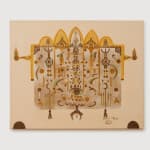Juliana SERAPHIM Palestinian-Lebanese, 1934-2005
Now considered one of the pioneers of the celebrated Beirut art scene which emerged in the 1960s, Seraphim’s unique form of Surrealism marks her out from her contemporaries. Considered an outsider by the more politically active artists, her artworks didn’t explicitly engage with the Palestinian national cause; instead, she developed a unique, sensually visual vocabulary rooted in the perception of a “woman’s world”. Her paintings are characterised by layers of erotic, dreamlike imagery and characters that morph into plants and flowers. Seraphim’s works embody spirituality, sexuality, mythology with her own childhood memories and upbringing; merging the beautiful with the grotesque and executed in a hyper-feminine style.
Seraphim was one of the first Lebanese women artists to survive entirely from her art; she represented Lebanon in international exhibitions, including the biennials of Alexandria, 1962, Paris, 1963, and São Paulo, 1965.
Recent important group exhibitions which have have cemented her position include 'Arab Presence, Modern Art and Decolonization: Paris 1908 – 1988', Musée d’Art Moderne, Paris, 2024 and 'Beirut and The Golden Sixties', Biennale de Lyon, 2022.



